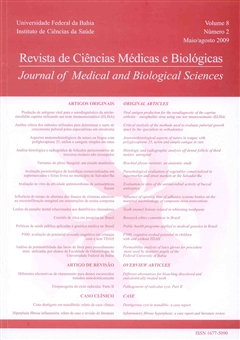Different alternatives for bleaching discolored and endodontically treated teeth
DOI:
https://doi.org/10.9771/cmbio.v8i2.4073Keywords:
Dental bleaching - Non-vital teeth - Aesthetic.Abstract
The bleaching procedures in discolored non-vital teeth after the endodontic treatment is an aesthetic treatment that offers more preservation of dental structure and low cost, especially when compared to the invasive procedures, as the use of veneer or crowns. The hydrogen peroxide, carbamide peroxide and sodium perborate can be used in the internal and external tooth surface or inside the pulp chamber, followed by the coronary seal and the change of the bleaching materials in different periods of time – the Walking Bleach technique. The application of warmth to accelerate the dental bleaching chemical reaction (thermo catalytic technique) has been questioned for the fact of consisting in a risk factor to the development of root reabsorption principally when exists trauma history in the tooth that will be bleached or defects in root cement. Therefore, the accuracy indication of the material to be used should have as a support the knowledge of the different alternatives of bleaching for these teeth, observing the efficiency of the various bleaching agents and the treatment safety to use each one of them. For this reason, the purpose of this paper is review the literature regarding different alternatives for bleaching discolored and endodontically treated teeth, the most used bleaching agents, advantages and disadvantages and possible collateral effects caused by these agents.Downloads
Download data is not yet available.
Downloads
Published
2009-06-02
How to Cite
Martins, J. D., Bastos, L. C., Gaglianone, L. A., Azevedo, J. F. G. de D. de, Bezerra, R. B., & Morais, P. M. R. de. (2009). Different alternatives for bleaching discolored and endodontically treated teeth. Journal of Medical and Biological Sciences, 8(2), 213–218. https://doi.org/10.9771/cmbio.v8i2.4073
Issue
Section
Review Articles
License
The Journal of Medical and Biological Sciences reserves all copyrights of published works, including translations, allowing, however, their subsequent reproduction as transcription, with proper citation of source, through the Creative Commons license. The periodical has free and free access.


